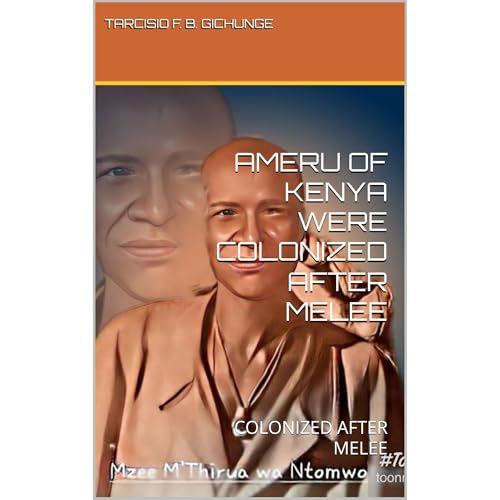
AMERU OF KENYA WERE COLONIZED AFTER MELEE
COLONIZED AFTER MELEE
No se pudo agregar al carrito
Solo puedes tener X títulos en el carrito para realizar el pago.
Add to Cart failed.
Por favor prueba de nuevo más tarde
Error al Agregar a Lista de Deseos.
Por favor prueba de nuevo más tarde
Error al eliminar de la lista de deseos.
Por favor prueba de nuevo más tarde
Error al añadir a tu biblioteca
Por favor intenta de nuevo
Error al seguir el podcast
Intenta nuevamente
Error al dejar de seguir el podcast
Intenta nuevamente
$0.00 por los primeros 30 días
Escucha audiolibros, podcasts y Audible Originals con Audible Plus por un precio mensual bajo.
Escucha en cualquier momento y en cualquier lugar en tus dispositivos con la aplicación gratuita Audible.
Los suscriptores por primera vez de Audible Plus obtienen su primer mes gratis. Cancela la suscripción en cualquier momento.
Compra ahora por $4.00
-
Narrado por:
-
Virtual Voice

Este título utiliza narración de voz virtual
Voz Virtual es una narración generada por computadora para audiolibros..
INTRODUCTION
By Gichunge WA M’Thirua
Ameru of Kenya have a long and interesting history in their existence. Their history traces back to when they crossed The Red Sea where they were created by God to live in Egypt for millenniums. In Egypt they were experts of the Pyramids construction. They escaped from Egypt after refusing to surrender their knowledge of Pyramids construction technology. They escaped and arrived in Mboa (Manda Island) in the Kenyan Coast around AD 1100 after they had meandered in the wilderness of Egypt, Nubia and Meroe from AD 745 to AD 1050 or AD 1100.
In Mboa, they again became victims of Slavery by the Portuguese who hunted them for export to Americas from AD 1500s. Ameru escaped from Mboa around AD 1650 and they meandered in the wilderness of Bura, Tulla and Murera up to around AD 1700 when they arrived in Meru. It is then when they started circumcision of their sons whom they had stopped to circumcise while in the wilderness.
They also resumed practice of their customs, culture and traditions which they had foregone in the wilderness. Nearly two centuries later, White people arrived in Meru through the Slavery Route by Arabs who had followed Ameru in the hinterland. That time because Slavery had been abolished, they were traders of Ivory tasks and other commodities which they exchanged with beads and other items.
Ameru named those traders CHOMBA, while they named the Missionaries who followed them ACHUNKU meaning WHITES who came to preach the word of God. Later followed the Colonizers who came to colonize and rule the communities in Kenya. Communities in Kenya named them BEBERU or Colonizers who arrived in AD 1880s.
In Meru the colonizers had very difficult times trying to conquer and colonize Ameru community. Unlike with other tribes of Kenya, Ameru were complicated in their Democracy that already had three arms of Government. Ameru community had an Executive arm of their Governance (Kaura O’Becau) they had The Legislature (Njurincheke) and they had The Judiciary (The Mugwe) who ruled Ameru before the arrival of the colonizers. The colonizers found it almost impossible to colonize Ameru because they had a Democratic Government that made laws and rules for its community. The colonizers were tossed in their effort to understand Ameru before finally Ameru agreed to be colonized on being assured protection of their land from occupation by intruders.
Ameru before colonization judged and punished offenders against their laws and rules that were in existence. The colonizers wanted to discover how the community managed its Democratic Government while the community dodged the colonizers for many decades that followed colonization. In Meru colonization began with a good District Commissioner named Edward Butler Horne (Kangangi) in 1906 who had passed through Chuka from Embu. It was Kangangi who marked Meru Boundaries with Chief Mbogori of Mwimbi and Chief M’Iminuki of Muthara in Tigania.
Pr
The colonizers approached Ameru in a friendly manner in order from a different route to colonize them. Much later, and in-between, in Kiambu Reserve, settlers had created space for themselves by removing Kikuyu from their lands to Meru Ngaya Forest in Igembe. The settlers argued their case of settling people from Kiambu Reserve to Meru Reserve on assimilation grounds that of NCHIARWA and AROMBI (or AHOI in Kikuyu).
The issue of Nchiarwa or Arombi (Kikuyu Ahoi) became a good reason for Ameru to accept colonization in order to be protected from intruders of their land!
Now read on to learn how Ameru behaved towards the colonizers from the beginning to the end of colonization in December 1963. Less land was grabbed in Meru because Ameru were advised by their governors and Njurincheke.
Todavía no hay opiniones


